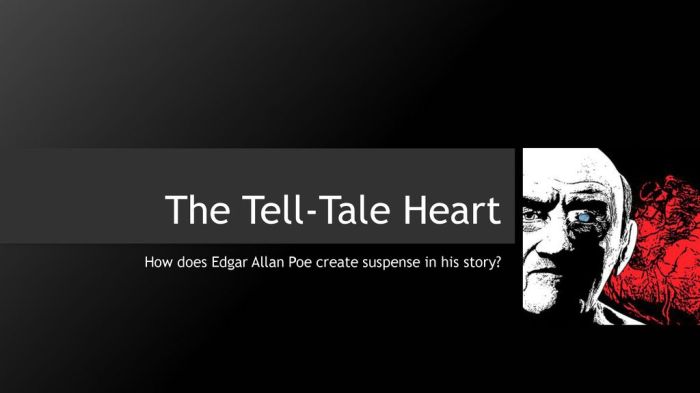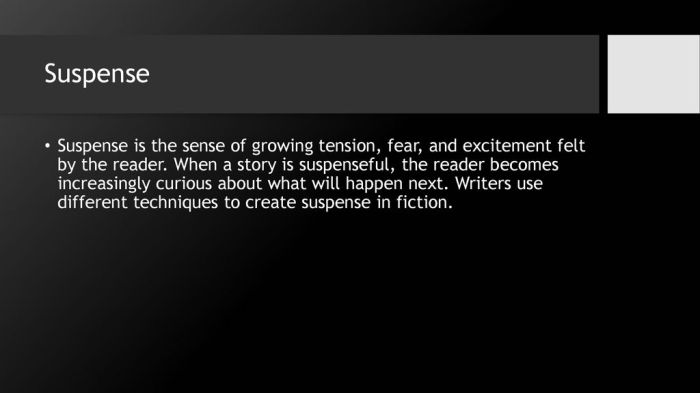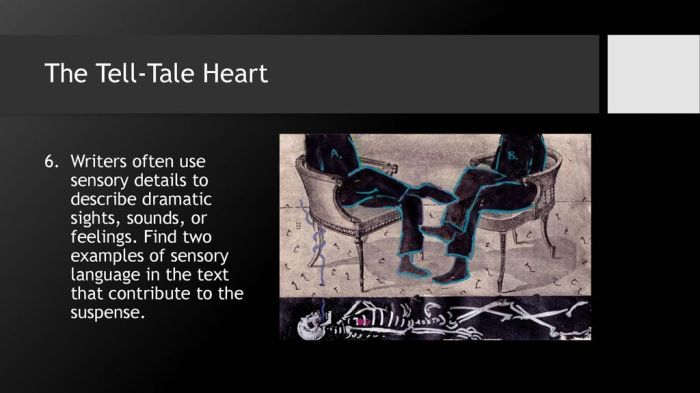How does edgar allan poe create suspense in this stanza – Edgar Allan Poe’s masterful creation of suspense in a poetic stanza is a testament to his literary genius. Through his skillful use of imagery, language, rhythm, sound devices, symbolism, and foreshadowing, Poe immerses readers in an atmosphere of unease, anticipation, and foreboding.
Poe’s vivid and evocative imagery paints a haunting and unsettling scene, setting the stage for the suspense to unfold. His choice of words and phrases is deliberate, creating a sense of tension and unease that permeates the stanza.
Edgar Allan Poe’s Use of Suspense in “The Raven”

Edgar Allan Poe is renowned for his mastery of suspense and atmosphere in his literary works. In the iconic poem “The Raven,” Poe employs a range of literary devices to create a palpable sense of unease and anticipation.
Poe’s Use of Imagery
Poe’s vivid and evocative imagery paints a haunting and unforgettable picture in the reader’s mind. For instance, the opening lines depict a “dreary, ghost-ridden” night, while the raven’s “startling eyes” seem to pierce the narrator’s soul. These vivid images establish an eerie and unsettling tone from the outset.
Poe’s Use of Language
Poe’s precise and deliberate choice of words and phrases further enhances the suspense. The repetition of the word “nevermore” creates a haunting and inescapable refrain, while the use of alliteration in phrases like “night’s Plutonian shore” adds to the poem’s ominous atmosphere.
Poe’s Use of Rhythm and Meter
The poem’s rhythm and meter also contribute to its suspenseful pacing. The trochaic octameter creates a slow and deliberate rhythm, while the regular rhyme scheme adds a sense of predictability and inevitability. This juxtaposition of predictability and unease creates a heightened sense of anticipation.
Poe’s Use of Sound Devices
Poe’s use of sound devices, such as alliteration, assonance, and consonance, creates a sense of foreboding and unease. For example, the repetition of the “s” sound in the line “Sitting lonely on the placid bust of Pallas just above my door” mimics the narrator’s obsessive thoughts and adds to the poem’s unsettling atmosphere.
Poe’s Use of Symbolism
Poe’s use of symbolism adds depth and resonance to the poem’s suspenseful atmosphere. The raven itself is a symbol of death and despair, while the bust of Pallas, the goddess of wisdom, represents the narrator’s futile search for answers and solace.
These symbols enhance the poem’s overall sense of foreboding and loss.
Poe’s Use of Foreshadowing, How does edgar allan poe create suspense in this stanza
Throughout the poem, Poe employs subtle hints and clues that foreshadow the narrator’s tragic fate. For instance, the raven’s perch on the bust of Pallas suggests the narrator’s impending madness, while the bird’s refusal to leave symbolizes the narrator’s inevitable descent into despair.
These instances of foreshadowing create a sense of anticipation and unease, keeping the reader on the edge of their seat.
FAQ Insights: How Does Edgar Allan Poe Create Suspense In This Stanza
How does Poe’s use of imagery contribute to the suspense?
Poe’s use of vivid and evocative imagery creates a haunting and unsettling scene, setting the stage for the suspense to unfold.
How does Poe’s choice of language enhance the suspenseful atmosphere?
Poe’s deliberate choice of words and phrases creates a sense of tension and unease that permeates the stanza.
How do rhythm and meter contribute to the pacing and suspense of the poem?
The rhythm and meter of the stanza create a sense of anticipation and unease, adding to the overall suspenseful atmosphere.


